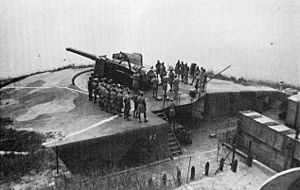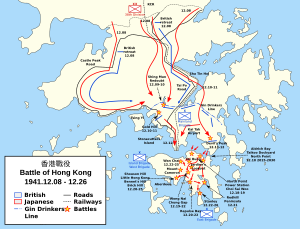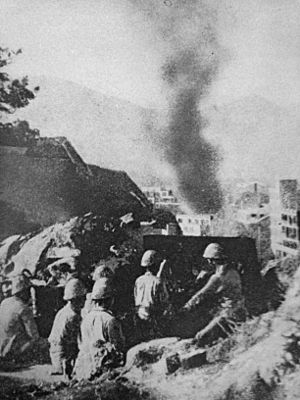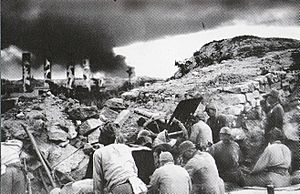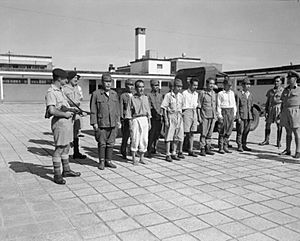Battle of Hong Kong facts for kids
Quick facts for kids Battle of Hong Kong |
|||||||||
|---|---|---|---|---|---|---|---|---|---|
| Part of the Pacific Theatre of World War II | |||||||||
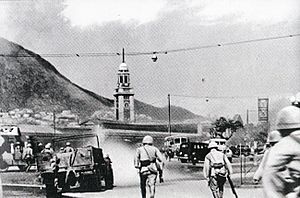 Japanese troops take Tsim Sha Tsui |
|||||||||
|
|||||||||
| Belligerents | |||||||||
| Commanders and leaders | |||||||||
|
|||||||||
| Strength | |||||||||
| 10,976-14,564 troops 5 planes 1 destroyer 4 gunboats 1 minelayer 8 MTBs |
26,928 troops 47 planes 1 cruiser 3 destroyers 4 torpedo boats 3 gunboats |
||||||||
| Casualties and losses | |||||||||
| 1,560–2,278 killed or missing 2,300 wounded 10,000 captured 1 destroyer captured 4 gunboats sunk 1 minelayer sunk 3 MTBs sunk 5 planes lost |
675 killed 2,079 wounded 2 planes damaged |
||||||||
| Civilian casualties: 4,000 killed 3,000 severely wounded |
|||||||||
The Battle of Hong Kong (8–25 December 1941) was one of the first battles of the Pacific War in World War II. On the same morning that Japan attacked Pearl Harbor, Japanese forces attacked the British colony of Hong Kong. This happened around the same time Japan declared war on Great Britain.
The Hong Kong defenders included soldiers from Britain, India, and Canada. Local defense groups like the Auxiliary Defence Units and the Hong Kong Volunteer Defence Corps (HKVDC) also fought. Within a week, the defenders left two of Hong Kong's three mainland areas: Kowloon and the New Territories. Less than two weeks later, with their last area, Hong Kong Island, unable to be held, the colony surrendered.
Why the Battle Happened
Britain started seeing Japan as a threat after their alliance ended in 1921. This threat grew in the 1930s as the Second Sino-Japanese War got worse. By October 1938, Japan had taken Canton, surrounding Hong Kong.
British studies showed that Hong Kong would be very hard to defend if Japan attacked. Still, in the mid-1930s, they began improving defenses, including a line called the Gin Drinkers' Line. By 1940, Britain decided to keep only a small number of soldiers in Hong Kong.
However, in September 1941, they changed their minds. They thought more soldiers would stop Japan and show China that Britain was serious about defending Hong Kong. The plan was to slow down the Japanese in the New Territories and Kowloon to destroy important buildings and supplies. The Gin Drinker's Line was supposed to hold for at least three weeks. After that, all defenders would move to Hong Kong Island. They would defend the island and keep the harbor safe until help arrived from Singapore or the Philippines.
Who Fought: The Forces Involved
Allied Forces
About 11,000 to 14,500 Allied soldiers fought in Hong Kong on December 8, 1941.
| Group | Number of Soldiers |
|---|---|
| British | 3,652 |
| Local Colonial | 2,428 |
| Indian | 2,254 |
| Auxiliary Defence Units | 2,112 |
| Hong Kong Volunteer Defence Corps | 1,787 |
| Canadian | 1,982 |
| Nursing Detachment | 136 |
Indian Army Soldiers
The 5/7th Battalion, Rajput Regiment, arrived in Hong Kong in June 1937. The 2/14th Battalion, Punjab Regiment, came in November 1940. Indian soldiers also served in other groups, like the Hong Kong Singapore Royal Artillery. This group had Indian (Sikh) gunners. Many medical staff from India helped the injured. Indian ex-soldiers working as security guards also suffered many losses.
Hong Kong and Singapore Royal Artillery
These soldiers operated coastal defense guns. Batteries at places like Stonecutters Island and Mount Davis helped support the ground troops. They fought until they were destroyed or surrendered. This group, which included soldiers from India, also had many casualties. Their names are remembered at Sai Wan War Cemetery.
Canadian Army (C Force)
In late 1941, Canada sent about 2,000 soldiers to Hong Kong. This group, called "C Force," arrived on November 16. It included soldiers from the Royal Rifles of Canada and the Winnipeg Grenadiers. Most Canadian soldiers had little battle experience. They were almost fully equipped, but they lacked some important weapons and ammunition. Their vehicles never arrived, as the ship carrying them was sent to the Philippines.
The Royal Navy had only a small force in Hong Kong. This included three old destroyers, four river gunboats, a new but lightly armed minelayer, and several small torpedo boats.
Royal Marines
About 40 Royal Marines were stationed at HMS Tamar, a shore base. They fought bravely against Japanese forces in Magazine Gap. Their commanding officer told them to defend the island "to the last man and last round."
Royal Air Force
The Royal Air Force (RAF) at Kai Tak Airport had only five planes. These were two Supermarine Walrus amphibious planes and three older Vickers Vildebeest bombers. An earlier request for more fighter planes had been turned down.
Other Forces
The Chinese Military Mission in Hong Kong worked with the British. They helped organize local agents and remove groups that supported Japan. A small group of Free French soldiers also fought alongside the local Hong Kong Volunteer Defence Corps. These were all World War I veterans and fought well.
The Battle Begins
Fighting in the New Territories and Kowloon
The Japanese attack began at 6:00 AM on December 8, 1941. Japanese soldiers crossed the Sham Chun River. At 8:00 AM, Japanese planes bombed Kai Tak Airport, destroying most of the RAF planes. They also bombed Sham Shui Po Barracks.
The first major fighting happened at 3:00 PM. Indian soldiers engaged the Japanese. Despite some early successes, the defenders had to pull back towards the Gin Drinker's Line. Late that night, all units were ordered to withdraw to this main defense line.
On December 9, Japanese forces reached Needle Hill. They found the Shing Mun Redoubt, a key part of the Gin Drinker's Line, unprepared. The Japanese attacked the redoubt at 11:00 PM. They quickly took over the trenches and tunnels. By the morning of December 10, the redoubt was lost. The Japanese had lost very few soldiers in this attack.
On December 11, the Japanese attacked Golden Hill. British and Indian soldiers fought back and briefly retook the hill. However, the British commander, General Maltby, decided that the New Territories and Kowloon could not be held. He ordered all forces to evacuate to Hong Kong Island. Demolition teams destroyed important buildings and supplies. Soldiers withdrew to Sham Shui Po Barracks and Jordan pier. Indian soldiers moved to protect the narrow Lye Moon Passage.
On the morning of December 11, the Japanese also landed on Lamma Island. They were met by fire from British guns. On the night of December 12, the Indian soldiers completed their evacuation to Hong Kong Island.
The Battle for Hong Kong Island
General Maltby divided the island's defense into East and West Brigades. The West Brigade, led by Brigadier John K. Lawson, was based at Wong Nai Chung Gap. This was a key pass between the north and south of the island. The East Brigade, led by Brigadier Cedric Wallis, was based at Tai Tam Gap.
On December 13, the Japanese offered surrender terms, but they were rejected. The Japanese then began shelling Hong Kong Island. Their artillery damaged several British gun positions.
On December 17, the Japanese again offered surrender terms, which were rejected. That night, Japanese teams explored the Taikoo area. The Japanese moved their forces closer to Hong Kong Island.
On December 18, the Japanese shelling of the island increased. At 8:00 PM, the first wave of Japanese soldiers began paddling towards Taikoo Dockyard. British and Indian soldiers fired on them. The Japanese landed at North Point, Sai Wan, and Aldrich Bay. By midnight, all six Japanese battalions were ashore. They faced barbed wire and fire from the defenders. The Japanese eventually pushed inland, moving towards the high ground.
In the early hours of December 19, Japanese soldiers moved towards Mount Parker and the Lyemun fortifications. They quickly overwhelmed the Lyemun Fort's defenders. They also captured Sai Wan Battery. Some Japanese soldiers harmed prisoners and medical staff at a dressing station.
In the West Brigade area, Brigadier Lawson sent Canadian soldiers to block the Japanese advance. The Japanese pushed through the weak defenses and captured Jardine's Lookout. By 7:00 AM, Japanese soldiers surrounded Lawson's headquarters. Maltby sent reinforcements, but few made it through. At 10:00 AM, Lawson radioed that his headquarters were surrounded. He was then killed by Japanese machine gun fire.
At 8:45 AM, British torpedo boats attacked Japanese boats in Hong Kong Harbour. They sank or damaged several Japanese vessels.
On December 20, the Royal Scots attacked the police station at Wong Nei Chung Gap but were pushed back. Canadian soldiers on Mount Butler surrendered after running out of ammunition. Sergeant-major John Robert Osborn of the Canadians bravely threw himself on a Japanese grenade to save his comrades. He was later awarded the Victoria Cross.
Japanese forces continued to advance, capturing Red Hill and Bridge Hill. They also reached the hills above Repulse Bay. The British warship HMS Cicala was sunk by Japanese bombers.
On December 21, the East Brigade launched a counterattack but faced heavy Japanese fire. They managed to capture Bridge Hill and Red Hill. However, by 5:00 PM, all their officers were wounded, and the force withdrew. On the north shore, Japanese soldiers pushed west towards Victoria Park.
On December 22, Japanese soldiers captured a position at Deepwater Bay. Two Japanese battalions attacked the Repulse Bay Hotel. The East Brigade was pushed back into the Stanley peninsula. On the north shore, West Brigade forces struggled to hold their lines. The Japanese attacked Stanley Mound and Sugarloaf Hill, forcing the defenders to withdraw.
By December 23, the main water reservoirs were controlled by the Japanese. Water supplies began to run out.
On December 24, the Royal Rifles withdrew to the Stanley defense lines. The Japanese attacked again, supported by tanks. The outer defense line broke, and defenders were forced back. At midnight, the Japanese entered the field hospital at St. Stephen's College. Many injured soldiers and medical staff were killed. On the north shore, Japanese soldiers advanced through Wanchai towards the dockyard.
The Fall of Hong Kong
On Christmas morning, Governor Young told Chinese Rear Admiral Chan Chak that he planned to surrender. Chan decided to escape. He was given command of the five remaining torpedo boats. Sixty-eight men, including Chan, successfully escaped to Mirs Bay. They met Chinese guerrillas and were taken to Huizhou. For this brave escape, Chan was later honored.
By the afternoon of December 25, 1941, it was clear that fighting more was pointless. At 3:30 PM, Governor Young and General Maltby officially surrendered to General Sakai at the Peninsula Hotel. At Stanley, Brigadier Wallis refused to surrender without a written order. He received it at 2:30 AM on December 26. Some isolated groups continued to fight even longer. The Central Ordnance Munitions Depot surrendered on December 27.
This was the first time a British colony had surrendered to an invading force. The defenders had held out for 17 days. This day is known in Hong Kong as "Black Christmas."
After the Battle
Casualties
The Japanese reported 675 men killed and 2,079 wounded. Other estimates suggest higher numbers for the Japanese. Allied forces suffered about 1,100 to 2,300 killed or missing, and many more wounded. Allied soldiers, including British, Canadian, and Indian troops, were buried at Sai Wan Military Cemetery and the Stanley Military Cemetery. Many Indian soldiers suffered heavy losses. Some Allied soldiers were killed by Japanese soldiers during or after surrendering.
Prisoners of War
About 11,000 Allied soldiers were captured by the Japanese. They were sent to various prisoner of war (POW) camps in Hong Kong and Japan. Many Canadian soldiers died in these camps due to harsh conditions and mistreatment. In 2011, a Japanese official apologized for the mistreatment to Canadian veterans. Civilians were held in the Stanley Internment Camp. Those who died there are buried in Stanley Military Cemetery.
Japanese Occupation
Isogai Rensuke became the first Japanese governor of Hong Kong. This began three years and eight months of Japanese rule. The Japanese 38th Infantry Division left Hong Kong in January 1942. The Hong Kong Defence Force became the main Japanese military unit in Hong Kong.
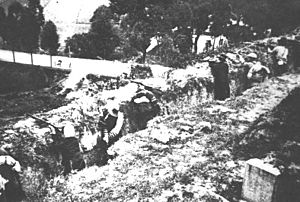
Local Chinese groups in the New Territories fought a guerrilla war against the Japanese. These resistance groups were known as the Gangjiu and Dongjiang forces. The Japanese destroyed several villages in revenge. The guerrillas continued fighting until the end of the Japanese occupation. General Takashi Sakai, who led the invasion and was governor for a time, was later tried as a war criminal and executed in 1946.
Awards for Bravery
Several individuals and groups received awards for their courage during the battle:
- Battalions from both Indian Army regiments earned special honors for defending Hong Kong.
- Gander, a Newfoundland dog, was awarded the Dickin Medal in 2000. He picked up a Japanese hand grenade and ran towards the enemy, dying in the explosion but saving several wounded Canadian soldiers.
- Colonel Lance Newnham, Captain Douglas Ford, and Flight Lieutenant Hector Bertram Gray received the George Cross. They showed great bravery by resisting Japanese torture after being captured. They refused to give information and were executed.
- Captain Mateen Ansari of the 5/7th Rajput's was also awarded the George Cross. He bravely refused to help the Japanese spread disloyalty among Indian prisoners. He was tortured for months and then executed in 1943.
Remembering the Battle
The Cenotaph in Central remembers those who died defending Hong Kong and in World War I. The shield on Hong Kong's colonial emblem from 1959 featured a battle design to remember the defense of Hong Kong in World War II.
The memorial garden at Hong Kong City Hall also remembers those who died in Hong Kong during World War II.
Images for kids
-
Statue of an anonymous World War I soldier. Also visible is the Battle of Hong Kong memorial plaque dedicated to all the defenders of Hong Kong in December 1941 through John Robert Osborn


